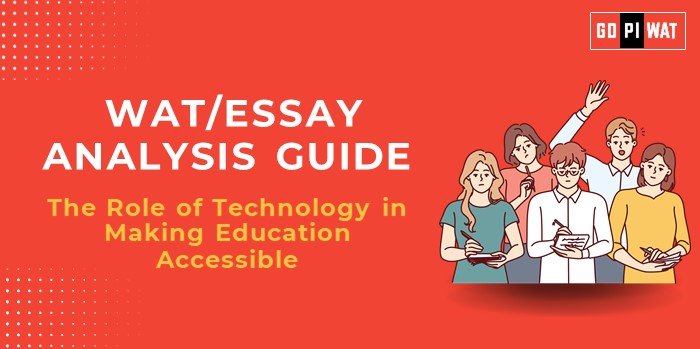📋 The Role of Technology in Making Education Accessible
🌐 Understanding the Importance of Technology in Education Accessibility
Context Statement: The ability of technology to bridge educational gaps is essential for B-school students, who will face the challenges of leading in a globally digitalized world. This essay topic is an opportunity to explore the transformative potential of technology in providing equitable education.
🕒 Effective Planning and Writing
- ⏳ Time Allocation:
- Reading & Planning: 5 minutes
- Writing: 20 minutes
- Review: 5 minutes
- 📖 Preparation Tips: Gather relevant statistics, outline the stakeholders, and consider the pros and cons of digital learning for a balanced argument.
✍️ Introduction Techniques for Essays
- 🔀 Contrast Introduction: “While digital education has made tremendous strides, nearly 37% of the global population lacks internet, highlighting a glaring gap in equitable access.”
- 💡 Solution-Based Introduction: “As technology advances, so does the potential to make education accessible; however, achieving universal access requires concerted efforts to bridge the digital divide.”
🏗️ Structuring the Essay Body
- 🏆 Achievements: Highlight the success of online platforms in democratizing education (e.g., 220 million learners globally).
- 📉 Challenges with Comparative Analysis: Discuss the limitations, particularly in rural areas or low-income countries, using global examples like Estonia and South Korea’s successful digital programs.
- 🔮 Future Outlook: Emphasize the need for partnerships and investment in technology for further growth in accessibility.
💡 Concluding Effectively
- ⚖️ Balanced Perspective Conclusion: “Technology in education holds the promise of accessible learning, yet achieving true equality requires addressing infrastructure and affordability.”
- 🌍 Global Comparison Conclusion: “Countries like Estonia and South Korea show the path forward, yet for universal impact, addressing the digital divide remains crucial.”
📊 Analyzing Successes and Shortcomings
- 🎨 Key Achievements: Enhanced reach of education, cost-effective solutions, innovative learning techniques.
- 💸 Ongoing Challenges: Unequal access, quality standards, cybersecurity risks.
- 🌎 Global Context: Countries with strong internet infrastructure, like Estonia, serve as models for others.
🚀 Recommendations for Sustainable Progress
- 📜 Public-Private Partnerships: Collaborate to fund digital infrastructure in underprivileged areas.
- 📱 Localized Solutions: Develop affordable, region-specific digital learning tools.
- 📘 Investment in Digital Literacy: Support programs that educate both students and teachers in using technology effectively.
✍️ Sample Short Essays on the Role of Technology in Education Accessibility
- ⚖️ Balanced Perspective: “While technology expands educational access, a persistent digital divide prevents equitable learning for all. Bridging this gap is critical to harnessing technology’s full potential in education.”
- 💡 Solution-Oriented: “Investing in public-private partnerships for internet infrastructure could significantly advance education accessibility, particularly in rural and low-income areas.”
- 🌍 Global Comparison: “Countries like South Korea demonstrate the impact of strong digital foundations, yet many parts of the world still lack the resources for similar accessibility in education.”


